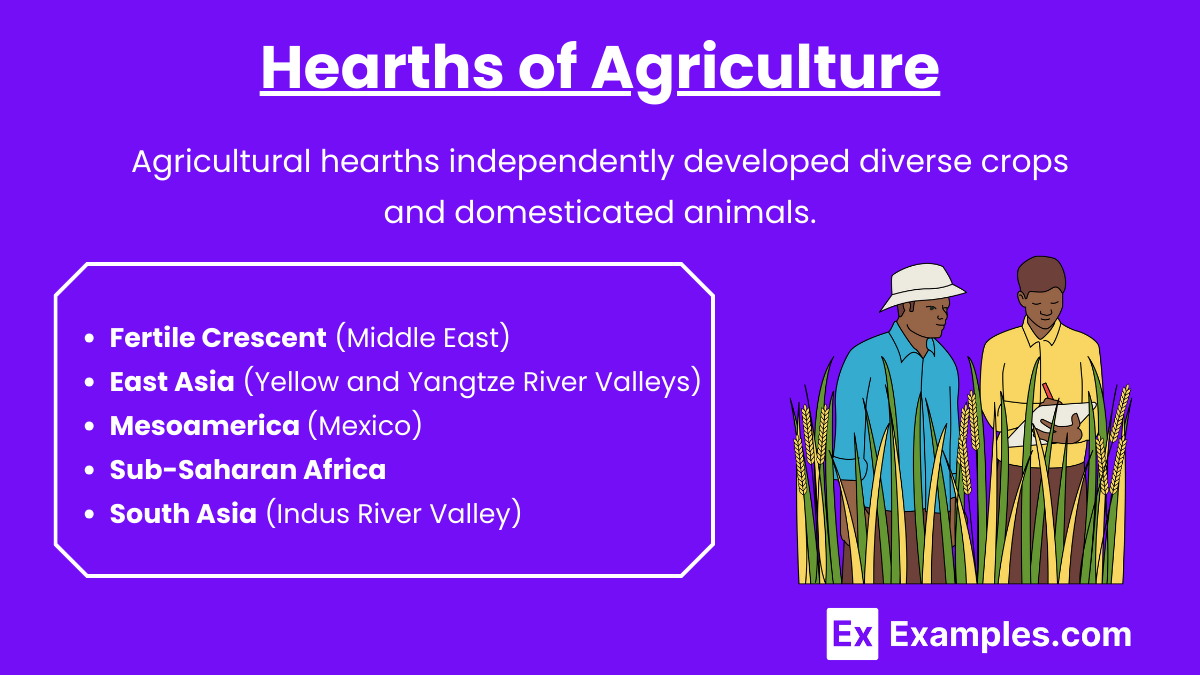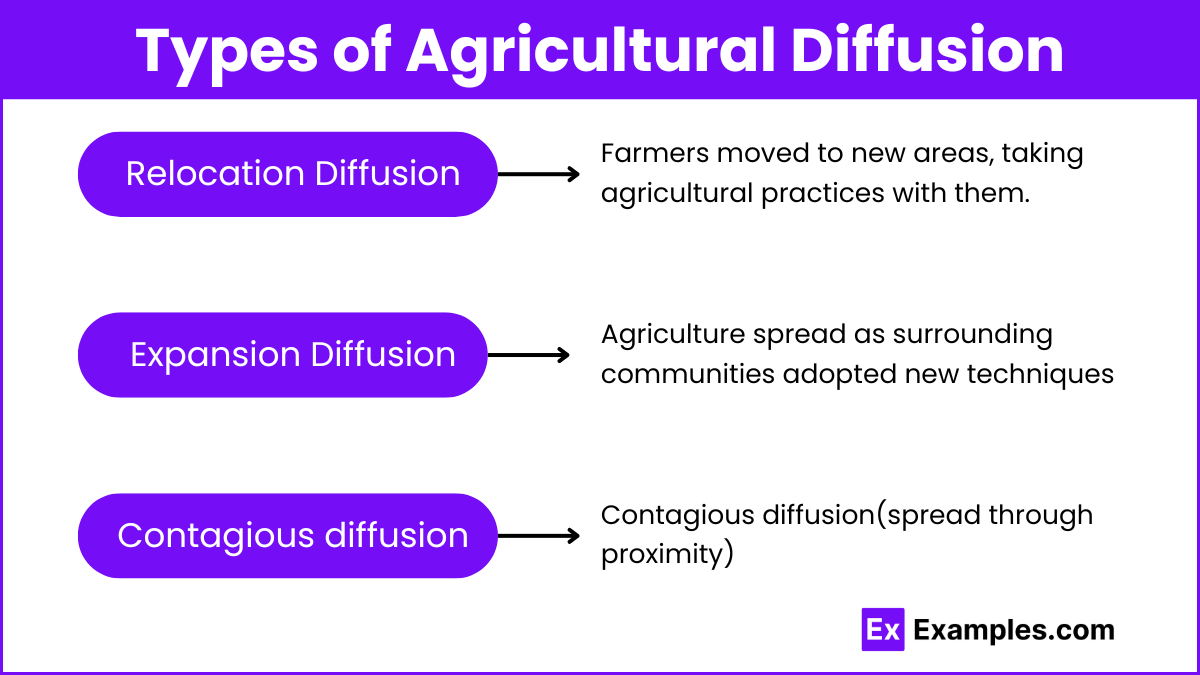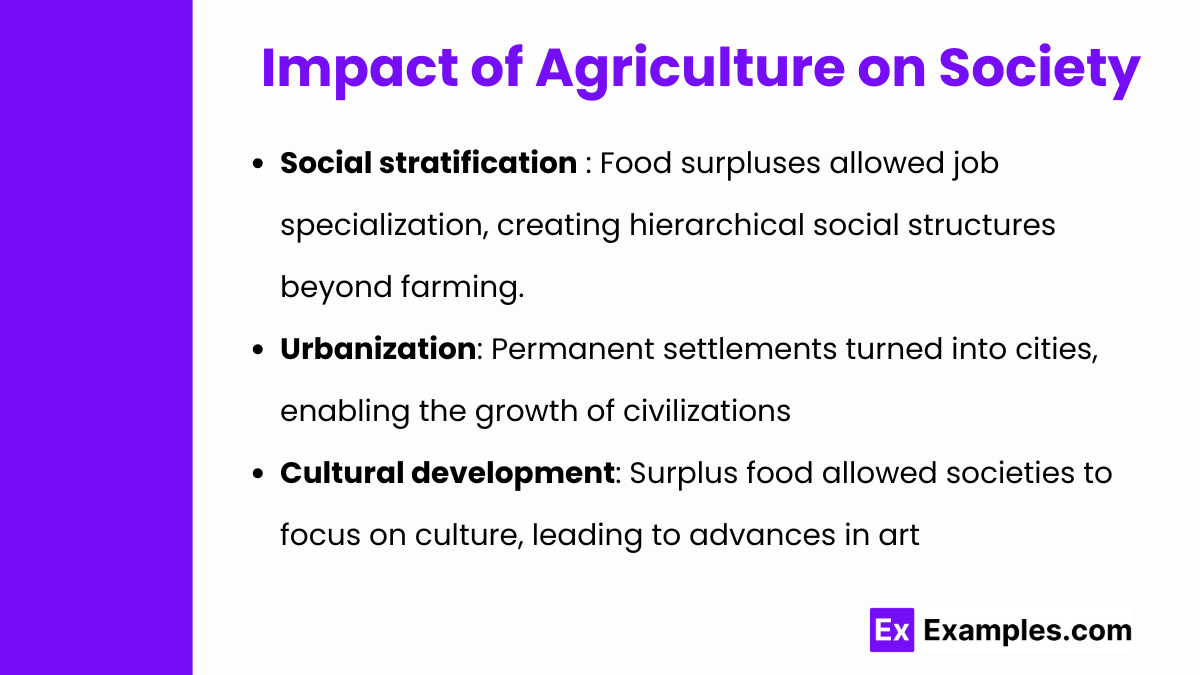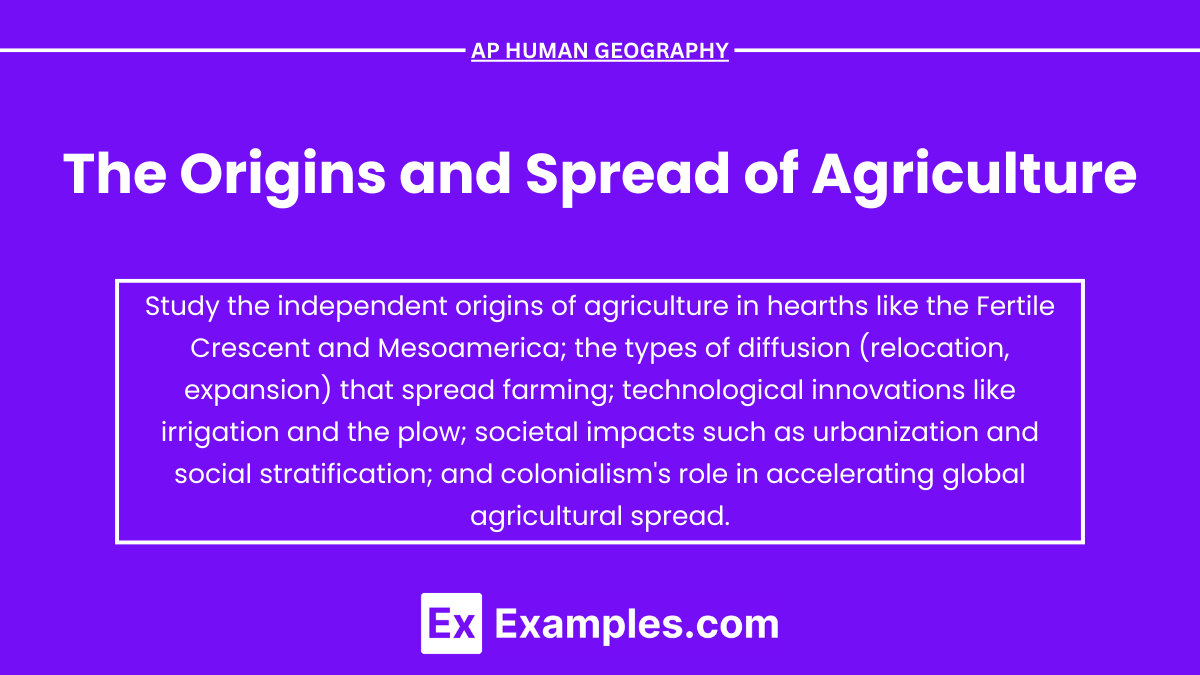The origins and spread of agriculture are fundamental topics in AP Human Geography, marking a pivotal shift in human history from nomadic hunter-gatherer societies to settled agricultural communities. This transformation, known as the Neolithic Revolution around 10,000 BCE, led to the domestication of plants and animals. Understanding these developments is crucial in AP Human Geography, as they explain the emergence of early civilizations, the diffusion of agricultural practices, and their profound impacts on cultural, economic, and environmental landscapes worldwide.
Learning Objectives
By studying “The Origins and Spread of Agriculture” for AP Human Geography, you should understand how the advent of agriculture transformed human societies from nomadic hunter-gatherers to settled communities. You should be able to identify the major agricultural hearths and explain how agricultural practices diffused globally. Additionally, comprehend the social, economic, and environmental impacts of agricultural development, including the subsequent agricultural revolutions and contemporary issues like sustainability, food security, and the role of technology in agriculture.
The Origins and Spread of Agriculture: Detailed Notes for AP Human Geography
Agriculture, as a transformative force, fundamentally altered human societies and landscapes. Its origins date back to the Neolithic Revolution (around 10,000 BCE) when humans began to domesticate plants and animals, transitioning from hunter-gatherer societies to settled agricultural communities. This shift allowed for permanent settlements, the development of complex societies, and population growth.
1. Hearths of Agriculture

Agriculture developed independently in several regions, known as agricultural hearths, where different crops and animals were first domesticated. These hearths include:
- Fertile Crescent (Middle East): Wheat, barley, lentils, and domestication of animals like goats and sheep.
- East Asia (Yellow and Yangtze River Valleys): Rice, millet, and later, soybeans.
- Mesoamerica (Mexico): Maize (corn), beans, and squash.
- Sub-Saharan Africa: Sorghum, yams, and millet.
- South Asia (Indus River Valley): Wheat and barley.
2. Types of Agricultural Diffusion

The spread of agriculture occurred through different forms of diffusion:
- Relocation Diffusion: Farmers moved to new areas, taking agricultural practices with them.
- Expansion Diffusion: Agriculture spread as surrounding communities adopted new techniques without major population movements.
- Contagious diffusion: (spread through proximity) and hierarchical diffusion (adopted by elites and spread downward in society).
3. Technological Innovations
Agriculture evolved through innovations like:
- Irrigation: Enabled the farming of arid areas, particularly in regions like Mesopotamia and Egypt.
- Plow technology: Allowed for more efficient soil preparation, increasing crop yields.
- Domestication of animals: Livestock, such as cattle and horses, provided labor, transportation, and food.
4. Impact of Agriculture on Society

The development of agriculture brought about:
- Social stratification: As food surpluses grew, not everyone needed to farm, leading to job specialization and hierarchical social structures.
- Urbanization: Permanent settlements turned into cities, enabling the growth of civilizations like Mesopotamia, Egypt, and the Indus Valley.
- Cultural development: Surplus food allowed societies to focus on culture, leading to advances in art, religion, and government systems.
5. Colonialism and the Spread of Agriculture
The spread of European colonialism in the 15th century greatly accelerated the diffusion of crops, animals, and agricultural practices across the globe:
- The Columbian Exchange facilitated the movement of crops between the New World and Old World. For example, maize, potatoes, and tomatoes were introduced to Europe, while wheat, sugarcane, and horses were brought to the Americas.
Examples
Example 1: The Fertile Crescent and the Domestication of Wheat and Barley
The Fertile Crescent, located in Southwest Asia, is often considered the birthplace of agriculture due to its early development of farming practices around 10,000 BCE. In this region, humans began to domesticate wild grains such as wheat and barley. The cultivation of these staple crops enabled the establishment of permanent settlements and the rise of complex societies like Mesopotamia. From the Fertile Crescent, agricultural practices spread eastward to the Indus Valley and westward into Europe through processes of diffusion and migration. This spread had a profound impact on human societies, facilitating population growth, urbanization, and the development of trade networks across continents.
Example 2: Rice Cultivation in East Asia and Its Expansion
In the river valleys of East Asia, particularly along the Yangtze River in China, rice was first domesticated around 7000 BCE. The warm, wet climate and fertile alluvial soils provided ideal conditions for rice cultivation. The development of paddy fields and irrigation techniques allowed for intensive farming, supporting dense populations and leading to the growth of early Chinese civilizations. Rice agriculture spread throughout East and Southeast Asia, reaching countries like Korea, Japan, Vietnam, and Thailand. This diffusion not only transformed diets but also influenced cultural practices, social structures, and economies in these regions, emphasizing communal labor and intricate water management systems.
Example 3: Maize Domestication in Mesoamerica and Its Diffusion
Maize, commonly known as corn, was first domesticated by indigenous peoples in Mesoamerica around 5000 BCE. As a versatile and highly productive crop, maize became the foundation of Mesoamerican civilizations such as the Maya and the Aztecs. The crop’s adaptability allowed it to grow in diverse climates and elevations, facilitating its spread northward into North America and southward into South America. The widespread cultivation of maize transformed agricultural systems and diets across the Americas. Following the Columbian Exchange in the late 15th and early 16th centuries, maize was introduced to Europe, Africa, and Asia, becoming a global staple and significantly impacting world agriculture.
Example 4: The Domestication of Potatoes in the Andes and Global Dissemination
In the high-altitude regions of the Andes Mountains in South America, the potato was domesticated around 8000 BCE. Indigenous societies, including the Inca Empire, relied heavily on potatoes as a staple food due to their nutritional value and ability to grow in harsh conditions. Advanced techniques for preserving potatoes, such as freeze-drying, were developed. After the Spanish conquest, potatoes were brought to Europe during the Columbian Exchange. Initially met with skepticism, the potato eventually became a crucial crop in Europe by the 18th century, supporting population growth and altering agricultural practices due to its high yield and nutritional content.
Example 5: The Bantu Migrations and the Spread of Agriculture in Sub-Saharan Africa
Beginning around 3000 BCE, the Bantu-speaking peoples of West Africa embarked on a series of migrations that lasted several millennia, moving eastward and southward across Sub-Saharan Africa. As they migrated, they introduced agriculture to the regions they settled, cultivating crops like yams, sorghum, and millet, and practicing ironworking. This agricultural knowledge allowed for more stable and dense populations compared to the hunter-gatherer societies they encountered. The spread of Bantu agricultural practices led to significant cultural and demographic changes, including the displacement or assimilation of indigenous groups, and laid the foundation for various African societies and kingdoms.
Multiple Choice Questions
Question 1
Which of the following regions is considered the earliest known agricultural hearth, where wheat and barley were first domesticated, and is often referred to as the “Cradle of Civilization”?
A) Mesoamerica
B) Sub-Saharan Africa
C) Southeast Asia
D) Southwest Asia (Fertile Crescent)
Answer: D) Southwest Asia (Fertile Crescent)
Explanation:
- Southwest Asia (Fertile Crescent) is recognized as one of the earliest centers of agriculture.
- Domesticated Crops and Animals:
- Crops: Wheat, barley, lentils, and olives.
- Animals: Sheep, goats, pigs, and cattle.
- Significance:
- The Fertile Crescent’s rich soils and favorable climate conditions facilitated early agricultural development.
- The domestication of wheat and barley allowed for food surpluses, supporting population growth and the development of complex societies.
- Incorrect Options:
- A) Mesoamerica: Known for maize (corn), beans, and squash but developed agriculture later than the Fertile Crescent.
- B) Sub-Saharan Africa: Domesticated crops like sorghum and yams, but not the earliest hearth.
- C) Southeast Asia: Early agriculture with crops like taro and bananas, but not considered the “Cradle of Civilization.”
Question 2
The spread of agricultural practices from their hearths to new regions through the movement of farmers is an example of which type of diffusion?
A) Contagious Diffusion
B) Stimulus Diffusion
C) Relocation Diffusion
D) Hierarchical Diffusion
Answer: C) Relocation Diffusion
Explanation:
- Relocation Diffusion:
- Definition: The spread of ideas, cultural practices, or innovations through the physical movement of people from one place to another.
- Application to Agriculture: Early farmers migrated to new lands, bringing with them seeds, domesticated animals, and farming techniques.
- Examples:
- The spread of agriculture from the Fertile Crescent into Europe as farmers moved and settled in new areas.
- Incorrect Options:
- A) Contagious Diffusion: Involves the rapid, widespread diffusion of a feature throughout a population without relocation (e.g., viral trends).
- B) Stimulus Diffusion: Occurs when a fundamental idea spreads, but specific traits are adapted (e.g., the adoption of rice cultivation methods suited to local conditions).
- D) Hierarchical Diffusion: Spread of ideas from authority figures or nodes of power to other persons or places (e.g., fashion trends from cities to rural areas).
Question 3
Which of the following was NOT a direct result of the Neolithic Revolution?
A) The development of settled communities
B) The creation of surplus food leading to specialization of labor
C) The widespread use of industrial machinery in farming
D) The beginning of social stratification and complex societies
Answer: C) The widespread use of industrial machinery in farming
Explanation:
- Neolithic Revolution (First Agricultural Revolution):
- Time Period: Around 10,000 BCE.
- Direct Results:
- A) Development of Settled Communities: Transition from nomadic lifestyles to permanent settlements due to reliable food sources.
- B) Creation of Surplus Food: Agricultural productivity exceeded immediate needs, allowing people to engage in activities other than farming.
- D) Beginning of Social Stratification: Emergence of different social classes based on wealth and occupation; leaders, artisans, and priests emerged.
- Incorrect Option:
- C) The widespread use of industrial machinery in farming:
- This was a result of the Second Agricultural Revolution and the Industrial Revolution in the 17th and 18th centuries.
- Introduced mechanization like iron plows and, later, tractors, which significantly increased agricultural productivity.
- Not a direct result of the Neolithic Revolution, which relied on simple tools and manual labor.
- C) The widespread use of industrial machinery in farming:


